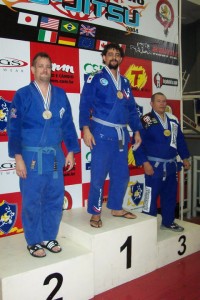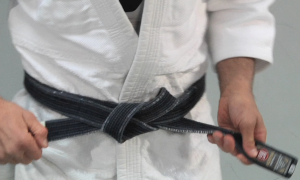
I was the worst white or blue belt that ever stepped on a jiu-jitsu mat.
That is completely true. I tell people that often at seminars, and I know many of them (perhaps most) think I am exaggerating. I absolutely am not. Not one bit.
In fact, I have a strong belief that I was my coach’s first pity blue belt. That is, he felt so sorry for me, and how hapless I was, and that all of my peers had passed me by and long had their own blue belt, and there I was still wearing that ratty, dirty white belt. I think Professor Megaton took pity on me and went ahead and gave me the next belt, undoubtedly assuming I would continue to suck and he would soon regret being a nice guy. My bud and hetero life mate Paul Sharp knew me back then, and he can tell you I was a joke as a martial artist. That is not fun to admit, but it is all too true.
Here is the true timeline of my jiu-jitsu journey. It took me seven years to go from my first day with Megaton to a one stripe blue belt. It took me four and a half more years to go from one stripe blue to black belt. So obviously for those first seven years I sucked. Bad. I fully embrace that and refuse to rewrite history to make me sound like more of a bad ass.
You may ask what changed. How did I suck so badly, but then make the switch and got good enough that I received a black belt from a man that most knowledgeable people in jiu-jitsu will tell you has some of the most stringent standards, especially for higher belts?
There is actually a specific moment and action that I can point to in answer.
In the spring of 2005, I competed in the BJJ Pan-American Championships. I had competed in some tournaments before and never really did well. This time, I exceeded any previous depths of awful-ness. I remember little about the match itself (thankfully), except that it was one of the most pitiful performances by any jiu-jitsu practitioner in history. All I can remember is thinking I should give my blue belt back to Meg, and take the team patch off my Gi so no one will know that I trained with him. I did not want to embarrass him any more than I already had (as a side note – Meg never made me feel bad about the match. He greeted me when I walked off the mat and patted my shoulder and simply said that it was time to get back to training. Most people don’t know that he has never said a bad word about any of his students when they compete, even when they fail badly. He believes that just honestly trying is worth a pat on the back. He truly believes that winning comes from being willing to try).
I left the venue pretty quickly and got in the car and headed home. Driving by myself through the desert towards home over the next six hours gave me plenty of time to think. I realized that I could never let what had just occurred happen again.
I had two options: 1) I could quit jiu-jitsu and never be humiliated again, but I would also forever be a quitter. Which unfortunately was how I had a tendency to handle things through my life. It was the easy path, but it also was deeply soul crushing. Or 2)I could suck it up, commit true energy towards jiu-jitsu (rather than just being there to get my ticket punched), lose weight, and get in fighting shape.
Most of the six hour drive was spent with the argument raging in my head. Finally, I decided – I was going to actually put real effort into something and push myself in a way that I had not really been tested.
The first thing I did was decide that no matter what, I was going to make BJJ class three times a week, and do all the training, even when the asthma was in full swing. I was not going to use that as an excuse to miss 1/3 of class, or even just miss a session entirely.
Second, I decided that I had to lose some of the 250 pounds plus of blubber I was rocking. Not just wanting to lose it, but truly take the steps to do so.
And third, start regular training at a sports performance facility under the eye of a coach who would hold me accountable and force me to work towards greater strength and cardio.
All that was cool, but I had done some of those steps before. We always “want” things. But we don’t always follow through. What I needed was something this time that would keep me in line and focused on the goal even when I mentally drifted. My solution? I was going to compete! But not just any competition – oh no. I decided I would go to Brazil and compete there, against the best in the world.
I was going to spend a good chunk of money on airfare, hotel, and various travel expenses and if I failed, it would all be a waste. And it would be a pretty public humiliation, because I decided to tell as many people as possible what I was going to do (this was pre-social media, or I would have posted it all over). I saw that the International Masters Championship was going to be held in Rio in August. Perfect! Four months to prep.
So I had a goal, and a fairly painful penalty for failing to meet that goal.
Not to bore people, but over the next four months I did follow through. I lost 35 pounds, got much more athletic and actually started to improve (finally!) at jiu-jitsu. And at the tournament in Brazil, even though I was actually forced to fight in the heavier weight category (that I spent the last four months getting out of!), I ended up taking home a silver medal, and even beat a Brazilian in the earlier round. And I only lost in the final by two points.
The most important thing that happened though was that I fell in love with jiu-jitsu. I began to see all the beautiful things that are part of this wonderful art. And in that realization, I began to steadily improve. Weird how a bit of focus and commitment actually can make a difference………….
What was my point in publicly revealing this painful admission? My point is essentially this: if we have an activity that is worthwhile, we owe it to ourselves to make some commitment to that activity. If the activity does not merit that commitment, we probably should not be wasting the time on it at all. It is either important, or it is not. Only the individual can decide for themselves what is worth the time and energy.
Whatever you do, put some effort into it.




